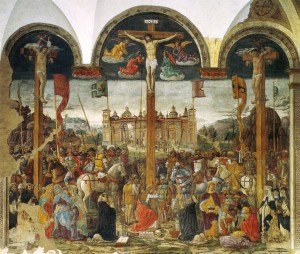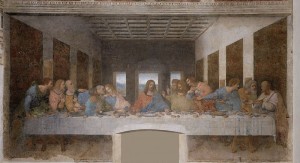While in Milan for a board meeting,1 I took a tour of the city that included a visit to the refectory of the Dominican monastery of Santa Maria delle Grazio. This is where da Vinci painted “The Last Supper“ on one of the end walls (painted between 1494 and 1498). On the opposite wall, another master painter (Giovanni Donato da Montorfano) painted “The Crucifixion“ in 1495. Both are huge paintings, each taking up the full wall. A doorway was later added to the dining hall and part of The Last Supper was lost (just below Jesus’ place at the table).
Here are the two paintings:
Da Montorfano painted a true fresco, which means he painted on wet plaster. This technique has its limitations:
- he had to paint a section at a time and complete it very quickly before the plaster dried, and
- he could not blend his colours.
Da Vinci tried a new technique – painting on dry plaster. This had the advantages that:
- he could take all the time in the world to paint as slowly as he liked,
- he could do preliminary work on the whole painting and then come back and work on the details, and
- he could blend his colours, have softer textures and paint the effect of sunlight into his work.
In addition, da Vinci used perspective in his painting, giving it a quasi 3-dimensional look. From halfway back in the dining hall, it looks like the dining hall carries on in the painting and that Jesus and the disciples are at the dining hall’s head table. The monks must have got quite a kick out of that!
But my main thought, in comparing the two paintings was to feel sorry for da Montorfano because he had the misfortune that his masterpiece, being permanently opposite to da Vinci’s masterpiece, would forever be compared unfavourably to it. I can imagine him looking over his shoulder as he was painting to see what da Vinci was doing!
And yet, if his painting could be moved anywhere else, it would be appreciated as the masterpiece it truly is.
Leaders and Spotlights
It made me think about senior leaders and their executive teams. Senior leaders usually get the credit (and the blame) for organizational results. They also have a ceremonial or figurehead function to fulfill. Often they are looked to as the model for what the organization stands for and aspires to be. They are, in short, in the spotlight. But must they keep the spotlight to themselves? Not if they know what they are doing.
Good senior leaders will make sure they include others in the spotlight of attention. They can do this because:
- If they are any good, they will have hired or promoted the very best people to the leadership team. The executive team should be full of top performers, highly capable in their fields, and at least one should be a credible candidate for the senior position. Each of these highly qualified executives deserves their own place in the spotlight.
- Sharing the attention with the executive team members demonstrates the strength of the team, and consequently, the organization. The shared spotlight acknowledges that organizational success is not dependent on one person alone, but on the combined capabilities of the executive team. It is the organization, not the individual that is the main thing.
- Certainly for topics related to the ministry’s programs, individual executive team members will likely have greater experience and hands on knowledge of a particular issue than the senior leader does, so they would best serve as the spokesperson for that area. When it comes to the ministry as a whole, I would expect that any of the senior leadership team would do a good job representing the ministry.
- Allowing others to share the spotlight enhances their leadership development and expands their ability to lead, because they develop their own contacts, referral sources, etc. and become stronger leaders.
- Sharing the spotlight shares the workload of being in the spotlight. It can be a lot for one person to bear.
- Sharing the spotlight also smooths the transition to a new leader when that time comes. Think of the transitions from Moses to Joshua, Elijah to Elisha, and Paul to Timothy and Titus (eg., Titus 1:5).
Organizations with active founders or strong personalities in leadership can find it hard to include others in the spotlight, even when the leader is willing to share the spotlight, because the public often wants to see or hear the person they identify the organization with. This is why senior leaders should encourage members of their executive teams (actually anyone within the organization) to have their own speaking engagements, give interviews, and publish articles. Let them build up a following because it all benefits the organization by raising its visibility and expanding the channels of influence for the sake of its mission.
In what ways do you encourage your executive team and other staff to have visibility inside and outside the ministry?
- CCCC is a member of ICFO, an international group of charity monitoring agencies, and I am on its board. ↩




